Бутовка
A sediment core 920 cm long was collected from the interior part of a raised bog using the hand-operated corer. The core included 110 cm of sandy clay, 190 cm of clayey gytrja and peat deposits, and 440 cm thickness of low-organic lake clay overlain by 180 cm of Sphagnum peat.
LPAZ 1 (790-920 cm) – clayey sand
LPAZ 2 (730-790 cm)—dark brown clayey gyttja (unit 2) and the lower peat layer
LPAZ 3 (680-730 cm) — brown peat
LPAZ 4 (620-680 cm) — brown peat
LPAZ 5 (530-620 cm) — grey-brown lake clay with high content of plant detritus
LPAZ 6 (475-530 cm) — the basal part of the light-grey lake clay
LPAZ 7 (395-475 cm) — lake clay
LPAZ 8 (315-395 cm) — lake clay
LPAZ9 (180-315 cm) – upper part of the light grey lacustrine clay
The core was sub-sampled for pollen analysis at 10 cm intervals. 500-600 pollen grains and spores per sample were counted in the organic sediments, 250-300 grains — in clayey sediments with low pollen contents. Relative frequency of pollen was calculated based upon the total terrestrial pollen and spores sum. In addition, pollen diagrams based on tree pollen sum (TPS) and non-arboreal pollen (NAP) sum were compiled, following the way of separate calculations for the main components of pollen spectra traditionally used in Russian literature. To calculate pollen concentrations, Lycopodium tablets (Stockmarr, 1971) were added to each sample. The pollen sequence has been divided into 12 local pollen assemblage zones (LPAZ) on the basis of changes in the composition of pollen and spores, aided by results of a constrained cluster analysis (CONISS; Grimm, 1987).
LPAZ 1 (790-920 cm) – Among arboreal pollen (AP), that of Pinus sylvestris is abundant, Picea and Betula alba are prominent. Rare pollen of Abies is registered. Of the shrubs, Betula humilis is the most important. In sub-zone la (815-920 cm), Betula nana reaches 10% of TPS. Pollen of Alnaster fruticosus, a cryophile shrub, widespread within the permafrost area, is also found in sub-zone la. Spores of another typical cryophyte, Lycopodium pungens, are registered in the same horizon. Artemisia dominates the NAP group. Pollen of Helianthemum — a typical heliophyte — indicates a wide spread of open landscapes. In sub-zone Ib (790-815 cm), AP makes up 80% of spectra, spruce reaching almost 50% of TPS. Rare pollen of Siberian tree species, Abies and Larix, occur here. Among NAP, Artemisia and Poaceae are predominant. On the whole, LPAZ 1 corresponds to the final stage of the Moscow Glaciation and transition to the Mikulino Interglacial epoch.
LPAZ 2 (730-790 cm) – Aquatic plants and thelmatophytes are especially diverse in sub-zone 2a, indicating that sedimentation took place in a shallow warm lake. With further warming the lake became filled in and overgrown, and a rich fen was formed in its place: in sub-zone 2b NAP is dominated by Cyperaceae. AP in LPAZ 2 reaches 95% of spectra due to a sharp rise in pollen contents of the broad-leaved trees: Ulmus (up to 40% of TPS in sub-zone 2a) and Quercus (up to 60% in sub-zone 2b). These species penetrated the forests of birch and Scots pine (Finns sylvestris) and rapidly replaced them. In sub-zone 2b, Tilia, Fraxinus, Acer, and finally Carpinus betulus appear. Pollen of species growing on damp ground (Alnus incana and Salix) is increasingly important in LPAZ 2.
LPAZ 3 (680-730 cm) — AP contents decrease to 80-85% mainly due to an increase in Polypodiaceae spores (up to 13% of spectra). Osmunda cinnamomea is registered in this layer. An increase in Carpinus (up to 40% of TPS in sub-zone 3b) and Tilia pollen contents at the boundary between LPAZ 2 and 3 is accompanied by a sharp decline of Ulmus and Quercus, as well as by the rise of Betula alba, Pinus, and Picea pollen curves. Pollen contents of Corylus avellana reach here 125% with respect to TPS. Broad-leaved forests dominated by Carpinus reached then the greatest species diversity, containing 3 species of Ulmus, 2 species of Quercus, 2 species of Tilia, Acer, and Fraxinus. This phase corresponds to the maximum warming for the entire sequence.
LPAZ 4 (620-680 cm) – Substantial changes occur within the AP group: the decline of the broad-leaved trees, Alnus glutinosa, and Betula alba, is accompanied by rise of Scots pine and spruce up to 45 and 30%, respectively. Along with pollen, stomata of Picea and Pinus are found in LPAZ 4. Rare pollen grains of Abies and Larix are registered. NAP content (mainly that of Poaceae) increases from 10 to 20% of the spectra. Pollen of herbs — inhabitants of wet meadows is both diverse and abundant Sphagnum curve rises, and pollen of Drosera—a typical plant of peat mires—is found in the layer with the highest content of Sphagnum spores. Spores of Osimmda, taiga species of club-mosses (Lycopodium selago, L. annotimm), and Pteridium aquilimm, inhabitants of pine and other light forests, occur frequently. These changes indicate an expansion of dark coniferous and pine forests with participation of broad-leaved trees and birch, reflecting a gradual cooling and increasing humidity of climate. The positive shift in the water balance once again brought about formation of a lake in place of the peat mire.
LPAZ 5 (530-620 cm) — AP decreases from 80 to 60%, Pinus (40-50%), Betula (up to 40%), and Picea (20%) being the main forest-forming trees. Pollen curve of Betula humilis rises; B. nana and Alnaster re-appear in the spectra. Presence of these cryophile shrubs suggests that pollen of the broad-leaved trees in this layer is re-deposited from the underlying sediments. The broad-leaved trees are also incompatible with Botrychium boreale and Selaginella selaginoides, registered in zone 5. Artemisia contents in LPAZ 5 reach 30% of NAP. Pollen of light-demanding and cold-tolerant plants (Helianthemum, Polemonium coeruleum, Thalictrum, Linum), as well as of the plants growing on eroded and sandy ground (Ephedra, Saxifraga, Plantago, Onagraceae) appears in the spectra. LPAZ 5 corresponds to the transition from the Mikulino interglaciation to the Early Valdai glaciation (zone M8 according to Grichuk, 1961).
LPAZ 6 (475-530 cm) – AP contents decrease to 15%. TPS is dominated by Betula alba (over 60%), while pine curve drops below 30%, and spruce remains as low as at the top of LPAZ 5. Pollen curves of mesophilic and cold-tolerant shrubs (Betula humilis, B. nana, Alnaster, and Salix) form distinctive peaks. Shrub and dwarf birch reach their maximum values for the entire section, their pollen concentrations being relatively high compare to other intervals within the layer of low-organic clay (Fig. 5 B). Poaceae and Ranunculaceae families, including mainly mesophilic plants, dominate NAP group. As in sub-zone 5b, pollen of the cold-tolerant and heliophile plants (Polemonium coeruleum, Thalictrum, Linum, Valeriana, Sanguisorba) often occurs. Inhabitants of the disturbed, sandy, and rocky soil (Fagopyrum, Saxifraga, Polygonum bistorta/viviparum, Onagraceae) are also typical for LPAZ 6. A gradual cooling reflected in LPAZ 5 continued during the initial stage of the Valdai glacial epoch. Vegetation became similar to the southern (shrub) tundra, or birch forest tundra.
LPAZ 7 (395-475 cm) – AP contents increase up to 40-45% of terrestrial pollen and spores. Pinus sylvestris curve rises from app. 40 to 60% of the TPS at the top of the zone, while Betula alba shows a marked decline. Larix pollen is registered in most samples of the zone. Spruce pollen curve forms a small but distinct peak in LPAZ 7. Pollen of Pinus sibirica is scarce. Of the cryophile shrubs, B.nana remains the most abundant, while B.humilis retreats gradually. Changes in the AP composition compare to LPAZ 6 indicate an increase in the continentality of climate, with wanner and possibly drier summer. Increasing role of Artemisia (up to 20% of NAP) and Chenopodiaceae, presence of plants, growing on barren or eroded ground (Centaurea cyanus, Onagraceae, and Hepaticae), and of typical xerophytes (Eurotia ceratoides), and heliophytes (Helianthemum supsp.) also indicate slightly warmer and drier summer conditions.
LPAZ 8 (315-395 cm) – AP contents drop to app. 10% — their minimum value for the entire profile. Tree pollen is represented almost exclusively by Pinus sylvestris – a prolific pollen-producing plant with pollen most easily transported by wind. Pollen percentages of cold-tolerant mesophilic shrubs, calculated with respect to the TPS, are low. Only pollen values of Alnaster fruticosus, a species characteristic to the regions with severe continental climate and spread of permafrost, slowly increase in LPAZ 8. Rare pollen grains of Abies and Pinus sibirica — also species with predominantly Siberian present-day ranges — are registered in this zone. Among herbaceous plants, Poaceae, Cyperaceae, and Artemisia are predominant, all of them forming peaks in pollen concentrations, accompanied by a smaller increase in Chenopodiaceae. Spores of typical cryophytes found in this layer (Botrychium boreale, Lycopodium pungens, Selaginella selaginoides) are indicative of cold climate.
LPAZ9 (180-315 cm) — The proportion of AP in the spectra increases to 50-60%. Tree pollen is dominated by Pinus sylvestris and Betula alba in sub-zone 9a, and only by pine in sub-zone 9b. Picea contents rise to app. 20%. Pollen curves of shrub and dwarf birch form peaks in the middle part of LPAZ 9. The maximum contents of Alnaster and Salix pollen are characteristic for sub-zone 9b. Pollen of Pinus sibirica occurs in most samples in this zone along with rare pollen of Abies and Larix. Hippophae rhamnoides, a heliophyte, is represented in sub-zone 9b. Poaceae dominates NAP group in sub-zone 9a, and Cyperaceae —in sub-zone 9b. Chenopodiaceae contents reach 15% of NAP in the lower part of the zone. Rare pollen of Ephedra is also recorded. Spores, represented mainly by Polypodiaceae and Sphagnum, reach 10% of the total spectrum. According to Grichuk (1969), these phases can be traced within a typical interstade, while minor warmings non-differentiated in terms of humidity of climate, such as the one reflected by LPAZ 7 in Butovka section, should be considered as «inter-phase» events.
Borisova O.K. Vegetation and climate changes at the Eemian/Weichselian transition: new palynological data from Central Russian Plain // Polish Geological Institute. Special Papers. №16. 2005. Pp. 9-17.


